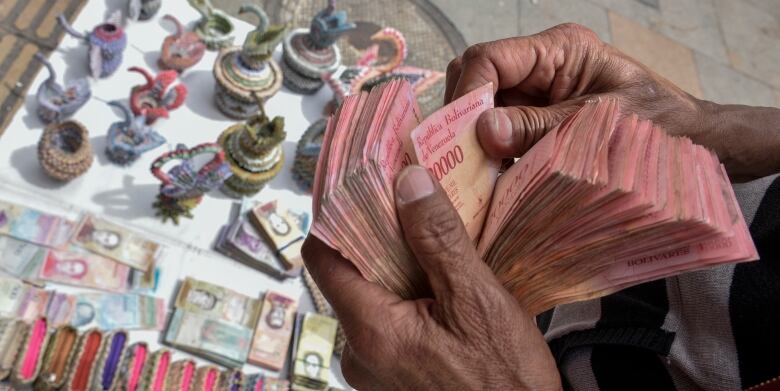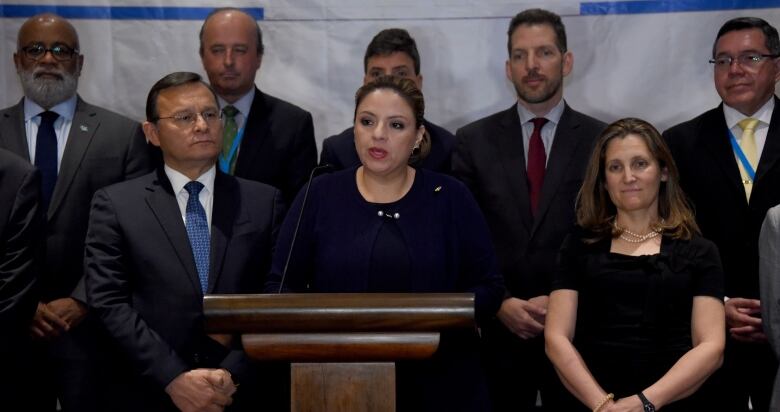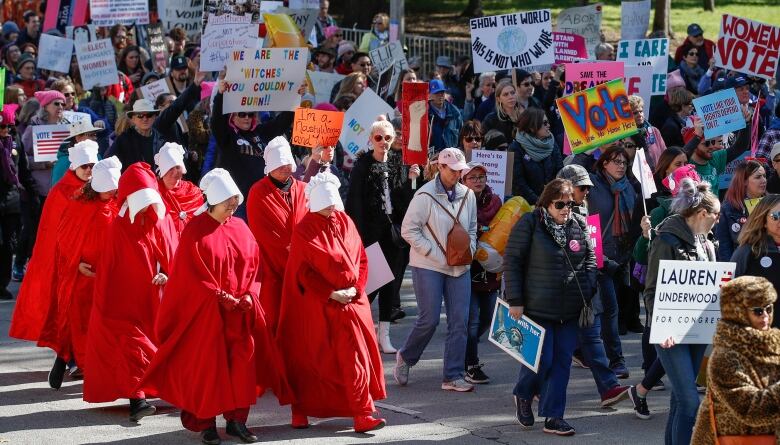Venezuela's exodus passes 4 million as U.S. sanctions strangle economy
Newsletter: A closer look at the day's most notable stories

Welcome toTheNational Today newsletter, which takes a closer look at what's happening around some of the day's most notable stories. Sign up hereand it will be delivered directly to your inbox Monday to Friday.
TODAY:
- The number of Venezuelans fleeingthe country's political and economic chaos has been picking up steam and has topped 4 million more than 12 per cent of the population.
- TheHandmaid's Talehas hit a nerve with a new generation of women's rights activists, but can wearing a bonnet and red cloak to a protest translate into meaningful political change?
- Missed The National last night? Watch it here.
Venezuela's exodus
The number of Venezuelans who have fled the country's political and economic chaos has now topped 4 million more than 12 per cent of the population.
The exodus has picked up steam in recent months as U.S. sanctions strangle the economy, with one million people leaving since November, according to new figures released by the UN and the International Organization for Migration this morning.
Most have sought refuge in neighbouring countries. Colombia is now home to 1.3 million displaced Venezuelans, followed by Peru with 768,000, Chile with 288,000, Ecuador 263,000 and more than 100,00 in both Brazil and Argentina.

But the flow is also pushing northward into the Carribean and Mexico, and the United States.
In 2018 Venezuela overtook China as the No. 1 source country for U.S. asylum claims, with almost 30,000 applications, bringing home a crisis that the Trump administration has fueled through its aggressive attempts to remove President Nicolas Maduro from power.
(Venezuelans find little sympathy at the American border: only about 2 per cent of claims were accepted last year, according to Dept. of Homeland Security figures.)
The recent surge in refugees may only be the beginning.
Last December, the UN predicted that the number of Venezuelans fleeing the country would hit 5.3 million by the end of 2019. A Brookings Institute study pegged the number at 8.2 million, based on a model that assumed the country would continue to produce 1.17 million barrels of oil its main source of foreign currency per day.
Venezuelan oil production fell to 874,000 barrels per day (bpd) in May, down 17 per cent from the month before, as foreign buyers like India bowed to U.S. pressure to curb their imports. The country's crude output has now dropped by more than one million bpd since 2017.
Yesterday, the United States moved to put further pressure on Venezuela's oil industry, warning international shippers that they may face penalties if they sell diluents chemical thinners that make it possible for the country to export its thick crude to the state oil company.
Meanwhile, the situation of average Venezuelans becomes more difficult by the day.
Annual inflation hit more than 1.3 million per cent last year, and almost 80 per cent of Venezuelan households can't afford enough to eat. Today, UNICEF warned that 3.2 million children are going hungry, and that under-five child mortality has increased by more than 50 per cent since 2014.

A $738 million US appeal for humanitarian assistance for Venezuela that the UN launched last winter has so far raised just 21 per cent of its goal.
The Maduro regime is trying to find other sources of foreign funds to keep itself afloat. Cocoa exports not yet subject to American sanctions have surged. And the country has been quietly peddling its central bank's gold reserves abroad.
What isn't clear is how this all ends.
Maduro seems to be firmly in control since an attempted coup by opposition leader Juan Guaido the man Canada and almost 60 nations recognize as the interim president fizzled early last month.

This week, the Washington Post published a secret recording of U.S. Secretary of State Mike Pompeo lamenting the fractious and disorganized Venezuelan opposition.
"[Maduro] is mostly surrounded by Cubans," Pompeo told a private New York meeting. "He doesn't trust Venezuelans a lick. I don't blame him. He shouldn't. They were all plotting against him. Sadly, they were all plotting for themselves."
The Secretary said that the U.S. strategy to dislodge Maduro is now focused on Cuba, his main backer.
"I think we've got to find a way to disconnect them from Venezuela," Pompeo said. "We're working our tail off to try and deliver that."
But other countries are still trying to broker some sort of political solution.
Norway, which has hosted two rounds of exploratory talks between the government and opposition, has envoys in Caracas today trying to build momentum for more meetings.
And Chrystia Freeland, Canada's foreign minister, will be meeting in Toronto this evening with Bruno Rodrguez, her Cuban counterpart, to discuss his talks with senior Maduro loyalists.

Russia remains a complicating factor.
Today, a foreign ministry official said that the Kremlin will consider sending more troops to Venezuela there are already about 100 there, maintaining anti-aircraft missiles and helping the Maduro government stave off cyber attacks if asked.
And Russian President Vladimir Putin, another staunch Maduro supporter, has issued a warning to those who seek to put Guaido in charge of Venezuela.
"If we adopt this way of coming to power then chaos will consume the world," Putin said during an appearance in St. Petersburg yesterday.
"I feel like asking those who support this: have you gone crazy, do you understand where this is going? Should there be rules or not?"
- Like this newsletter?Sign upand have it delivered by email.
- You may also like our early-morning newsletter, the Morning Briefstart the day with the news you need in one quick and concise read.Sign up here.
Pop panel
This week, Hulu's hit show The Handmaid's Tale is back for its third season, and it has struck a nerve with a new generation of women's rights activists. But as producer Tarannum Kamlani writes, can wearing a handmaid's costume to a protest translate into meaningful political change?
When it debuted on TV in April 2017, the latest adaptation of The Handmaid's Tale landed in a social landscape primed to give it maximum impact.
The show's source material, Margaret Atwood's novel of the same name, came out in 1985. The future she depicted a Christian theocracy where the few women able to have children are forced to have them for the rich and powerful seemed far-fetched to most people.
But 2017 was the beginning of Donald Trump's presidency. The political currents that brought him into the White House threatened to undo the victories that the women's right's movement had fought for decades to achieve.

Women protesting Trump have adopted the now-iconic crimson robes and white bonnets of the handmaids in the novel and the show, using them to convey both their opposition and to signal what they believe is at stake.
There's even a Handmaid's Coalition, complete with a guidebook on how to make your cloak and bonnet.
But what effect does showing up dressed as a handmaid at, say, the confirmation for Trump's Supreme Court nominee Brett Kavanaugh really have? He still won the nomination and has it for life.
Or is it enough that women have a language and a roadmap through which to process and express their fears for their future?

Our Pop Panel returns this week to ask these questions and more.
Andrew Chang is in the host's chair, and he's joined by freelance writer and editor Stacy Lee Kong, writer and podcaster Stephen Marche, and freelance writer Katie Underwood.
Hope you'll join us!
- Tarannum Kamlani
- WATCH: The Pop Panel tonight on The National on CBC Television and streamed online
Quote of the moment
"To me [wine] stank and it didn't taste nice, and I didn't want to drink anything at the parties with school friends. People were having beer and spirits and I thought it was disgusting ... That was my honest opinion."
- Marc Almert, recently crowned as the world's best sommelier, on his winding career path.

What The National is reading
- Canada's jobless rate drops to 5.4 per cent, lowest level in 43 years (CBC)
- U.S. opens new mass facility in Texas for migrant children (Associated Press)
- Labour beats Brexit Party in U.K. byelection (BBC)
- After 19 years, Christine Sinclair is on the verge of making soccer history (CBC)
- Russian TV to air own patriotic retelling of Chernobyl story (Guardian)
- Ampaire test-flies world's biggest electric plane (Deutsche Welle)
- Surgeons opened her skull to remove a tumor, they found a tapeworm (Washington Post)
- Walmart's new grocery home delivery service to your fridge (Fox Business)
Today in history
June 7, 1999: Garth Drabinsky takes Livent to the top
And then, the bottom.
Sign up hereand have The National Today newsletter delivered directly to your inbox Monday to Friday.
Please send your ideas, news tips, rants, and compliments tothenationaltoday@cbc.ca.













_(720p).jpg)


 OFFICIAL HD MUSIC VIDEO.jpg)
.jpg)



























































































